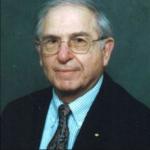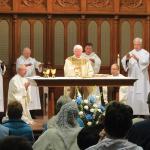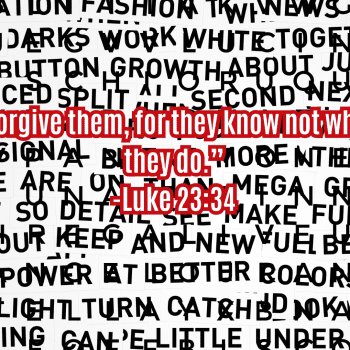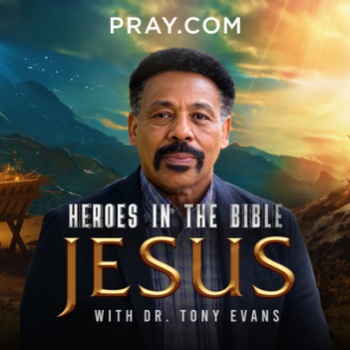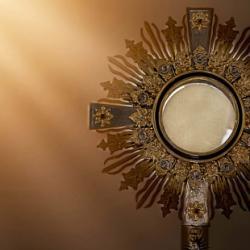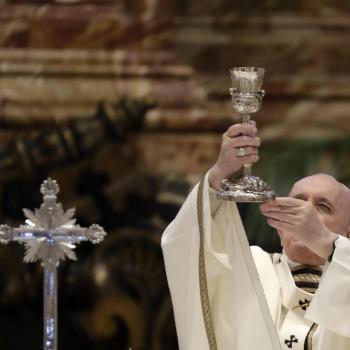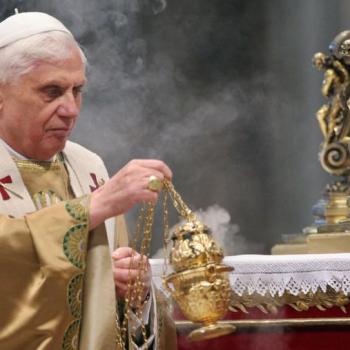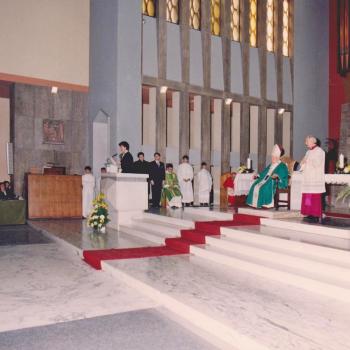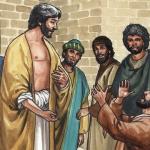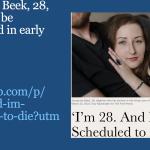The Liturgical Reform – Council, Consilium, Papacy – Part I: The Liturgical Path of the Church After Vatican II
Introduction
The Second Vatican Council, a watershed in the life of the Catholic Church, famously generated a number of significant reforms, particularly in the realm of the sacred liturgy. Central to these reforms was the document Sacrosanctum Concilium, a constitution that sought to renew the liturgy in the light of several centuries of formal stagnation in praxis and with the benefit of several centuries of profound liturgical scholarship carried out by such figures as Odo Casel, Dom Prosper Guéranger, Pius Parsch, Josef Jungmann, SJ, and Romano Guardini. The new constitution brought forth much renewal in its own right; nevertheless, the postconciliar period gave rise to further reforms by successor popes, reforms that sometimes arguably diverged from the express vision of the council itself. This five-part essay series will examine whether (and to what extent) the Church should adhere to the black letter of Sacrosanctum Concilium, or whether it should uncritically embrace all postconciliar reforms, or whether such a dichotomy can even be drawn, especially in view of the directives of the Holy See’s five “instructions on the correct implementation of the constitution on the sacred liturgy.”
Understanding Sacrosanctum Concilium
Sacrosanctum Concilium urged that the Church’s “rites be revised carefully in the light of sound tradition, and that they be given new vigor to meet the circumstances and needs of modern times” as the “summit toward which the activity of the Church is directed; [and] the font from which all her power flows . . . [for] the sanctification of men in Christ and the glorification of God.” And in their wisdom, the fathers of the Second Vatican Council perceived that “in order that the liturgy may be able to produce its full effects, it is necessary that the faithful come to it with proper dispositions, that their minds should be attuned to their voices, and that they should cooperate with divine grace, . . . ensur[ing] that [they] take part fully aware of what they are doing, actively engaged in the rite, and enriched by its effects.”
Given such an outlook, members of the lay faithful indeed contribute, per the council fathers, to “foster[ing] that full, conscious, and active participation demanded by the very nature of liturgy itself.” Key directives of the reform therefore included promoting this active participation, allowing the use of vernacular languages, and simplifying the rites while maintaining their intrinsic meaning. The goal was to ensure that moving forward, the Church’s liturgy would be treated not only as a clerical responsibility but a collective, communal expression of faith—the highest of which the Church is capable.
Postconciliar Implementation
Following the council, several popes introduced reforms to actualize the visions articulated in Sacrosanctum Concilium. However, concerns arose among both clerics and laymen about purported deviations from the council’s intentions. Some of these concerns were theologically valid, others were a result of rigorism, and still others represented a one-sided reaction to the tide of secularization sweeping across the world following two world wars and the rise and diffusion of communism and totalitarian ideologies.
To address these concerns, the Church issued five instructions on the correct implementation of the constitution on the sacred liturgy. These instructions served as guidelines to ensure that the reforms stayed true to the conciliar principles, emphasizing fidelity to the original texts, and attempting to strike the balance, as envisioned by the council fathers, between tradition and renewal, as well as incorporating some adaptation to local cultures.
Despite the issuance of these documents, they were not as widely implemented as the Church envisioned. Moreover, various indults were requested of the hierarchy for the enabling of practices foreign to the conciliar and postconciliar documents, such as Communion in the hand (a controversial practice excluded from the liturgy for many centuries for prudential reasons, though also found in the Mass of the early Church). There was also a notorious period of unsanctioned experiments, which rightfully drew the ire of the Church hierarchy and many conservatives.
Analysis and Comparison
The central question at hand, however, is whether the postconciliar reforms have adhered to the letter and spirit of Sacrosanctum Concilium and/or even whether it is necessary that they do. Although the instructions were meant to align postconciliar changes with the council’s vision, there have been instances of both congruence and divergence. For example, the expanded use of vernacular languages in liturgy certainly aligns with the council’s intentions, but many argue that within the four corners of Sacrosanctum Concilium, it’s clear the vernacular was never supposed to be the only language used.
Certain other critiques challenge the postconciliar status quo on topics such as biblical translations, inculturation, the exclusion of various long-standing prayers, and the new orientation of the celebrant to face the people during the liturgy of the Eucharist. Many insist that the reform, as it stands, has strayed from traditional norms, potentially diluting the sacrality and universality of the rites. The simple answer to this, of course, is that the pope always maintains his prerogative (cf. the dogma of his papal primacy of supremacy) to supersede earlier liturgical decisions—even those made at the behest of an ecumenical council.
The question for us today isn’t whether such supposed deviations therefore are illegitimate or whether we should go back to the original constitution on the liturgy in a sort of conciliarist Ressourcement movement, but rather whether and to what extent such changes the Church today considers necessary and permanent to the reform.
If the Church considers these changes necessary, how should the faithful proceed, especially those who disagree with the Church’s judgement? Should the faithful learn to accept that what they perceive to be deficiencies are permanent or normative?
Acceptance of these “authoritative deviations” from the council becomes both an issue of proper liturgical formation and a challenge for the faithful to grow in virtue—particularly in humility, obedience, patience, and forbearance where appropriate. Proper liturgical formation and a proper regard for authority can help us to discern what practices may be improved upon. This will allow us to see what the Holy Spirit wants to do for us and through us.
Tension
Both Sacrosanctum Concilium and the postconciliar reforms offered various theological and practical challenges. The council’s reforms made the liturgy more accessible and engaging for the laity in many cases. However, the postconciliar period, guided by the five instructions, has seen a struggle to maintain a balance between preserving tradition and adapting to contemporary contexts.
Some see the Novus Ordo (a moniker for the revised rite of the Mass) as a departure from the traditional rite. Others see it as reflecting a theological maturation, a result of the scholarship of the so-called Liturgical Movement, though simpler in form than the preconciliar liturgy. This tension reflects a broader debate within the Church about maintaining its identity while responding to modernity.
Contemporary Perspectives and Debates
The Church today stands at a crossroads. Traditionalists often advocate for either rigid adherence to Sacrosanctum Concilium’s black letter or for rejection of the reform entirely, fearing that too much adaptation can lead to a loss of reverence, identity, and universality. More mainstream conservatives and “John Paul II Catholics” on the other hand, tend to argue for the acceptance of and adherence to the liturgical reform undertaken by the postconciliar popes, despite whatever deficiencies may be present or perceived, in the hopes that a renewal of reverence and certain features of long-standing Catholic identity eventually find their place in the reformed order of the Mass, so as to satisfy the call to better meet modernity on its own terms while retaining distinctly Catholic worship.
Various proposals have been made about how this process could be undertaken, with some stressing first principles of liturgy (ars celebrandi, silence, natural symbols), while others have promoted a “reform of the reform,” seeking to reincorporate many of the traditional elements seemingly lost in the hastiness of the reform (and sometimes iconoclasm) during the ‘60s and ‘70s. In any case, the synodal role of the faithful in this debate is crucial, as their collective voice and experience, the sensus fidelium, can offer valuable insights into the efficacy and impact of these liturgical changes.
The Path Forward
It is evident that both Sacrosanctum Concilium and the postconciliar reforms, along with their corresponding guiding instructions, have significantly influenced the Catholic liturgy in our day (though there is much work still to be done). The path forward for the Church might not lie in pitting one authoritative document against another, but rather in finding the harmonious method that respects tradition while embracing necessary progress. This approach will require ongoing dialogue, deep theological reflection, and a commitment to unity within the global Catholic community. As the Church continues to navigate these liturgical waters, it must remain mindful of its rich heritage and the diverse needs of its faithful, always seeking to express the timeless truth of the Gospel in a language that speaks to the heart of each generation.
Part 2 can be found here: The Post-Conciliar Era and The Rise of Traditionalism


